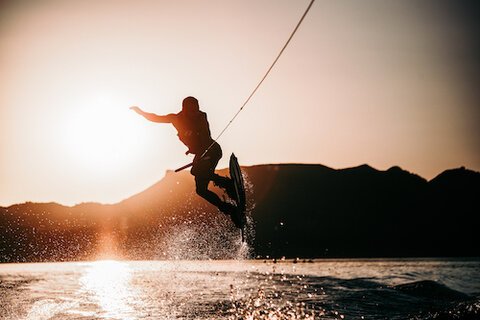Becoming comfortable on a stand up paddleboard takes time and practice. I sure didn’t feel confident the first time I tried to stand up paddleboard. If you’re new to the sport, these beginner tips can help you get the hang of managing the board and paddle alike.
 I sure didn’t feel so confident the first time I tried to standup paddle board, though. If you’re new to the activity, then knowing these beginner tips can help you get the hang of managing the board and paddle alike.
I sure didn’t feel so confident the first time I tried to standup paddle board, though. If you’re new to the activity, then knowing these beginner tips can help you get the hang of managing the board and paddle alike.
For starters, choose a good spot for your first time out. The water should be calm and flat, there should be little to no wind or current, and you should be able to launch somewhere that you can wade in from shore. Trying to step off a boat onto a paddleboard in deep water is a more advanced mounting technique. Take the baby steps first, and you’ll be happier in the long run.
Stand next to the board somewhere that the water is knee-deep, and get aboard in a position that allows you to kneel. You want your body slightly abaft (behind) the center of the board, usually a little bit behind the board’s handles. Once you feel OK in the kneeling position, put your hands on each side of the board, and—one foot at a time—work toward standing up. It can help to get your feet under you in the crouching position before you actually try to stand upright.
Once you’re standing (well done!) adjust your stance so that your feet are perpendicular to your hips, centered on the board so that you’re not putting more weight to one side or the other. Your knees should be slightly bent, and your back should be straight. Keeping your back straight not only helps with balance, but also helps you keep your eyes up and on the horizon, which is where they should be.
Next, go ahead and start to paddle. Have one hand on the paddle’s T-grip and the other hand a few feet below, on the shaft. Don’t try to paddle with both hands on the shaft; you want one hand on the T-grip so you can best control the paddle.
To move in somewhat of a straight line, alternate paddle strokes on either side of the board—switching which of your hands is on the T-grip, depending on which side of the board the paddle is on. Once you have that natural forward motion down, you can practice things like turning and a reverse stroke, which will help you slow down and stop.
And yes, know that you’re going to fall off the board and get wet. As a beginner, falling is inevitable. Just begin the process again from scratch, starting on your knees, and your confidence and skill will improve with every attempt.
Stowing the paddleboard on board a boat
When you’re done paddling for the day, there are a few ways to stow a paddleboard safely on a boat.
Companies like Manta make racks that can be mounted on board, with single- and double-board models available . Some racks include storage hooks for the paddles, and others don’t, so make sure you check the style before adding a rack system to your shopping cart. Also check your board’s thickness and ensure that the rack is built to accommodate it. (Paddle boards come in various thicknesses, lengths and shapes, depending on the user’s skill level.)
sure you check the style before adding a rack system to your shopping cart. Also check your board’s thickness and ensure that the rack is built to accommodate it. (Paddle boards come in various thicknesses, lengths and shapes, depending on the user’s skill level.)
Boaters with the right onboard setup also can use tie-downs (think bungee cords) to keep a paddleboard safely stowed. Depending on the type of boat and the stowage area, this can be a less-expensive option than investing in specialty racks.
And, of course, there’s always the option of choosing an inflatable board—which can then be deflated for easy stowage alongside just about anything else in a lazarette or other onboard compartment. Some inflatable boards come with carry bags that also make it easy to move the board from the boat to the beach, or back home at the end of the day.
